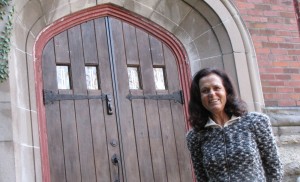
Perched on a hill looking over the Hudson River, the Garrison Institute still offers what its original founders intended ”“ a place to meditate and reflect, find inner peace and perhaps, in the process, make a difference in the world. Today, Capuchin monks no longer walk its halls, but for all who enter, no matter what denomination, the goal is the same.
The former monastery, built during the Great Depression, is still a living, breathing work of reflection and introspection. Its nonsectarian programs, retreats and seminars share a common theme: make the world a better place to live.
Since 2003, the Garrison Institute has helped to make that happen through workshops and meetings geared toward enriching the mind, giving rest to the spirit and hope that its visitors come away rejuvenated and ready to take on the ever-present problems of the world.
The Gothic-inspired building and the acreage surrounding it was rescued from the developer”™s wrecking ball by the Open Space Institute.
“John Adams (former OSI president) Â had an incredible vision for this place,” said Diana Rose, the Garrison Institute”™s founding president emeritus. “They wanted to preserve the monastery and the view, as well as give hikers access to the Appalachian Trail. They reached out to my husband, Jonathan, and to me, and we formed a partnership. We both had longtime meditation practices. Together with John and the team from OSI, we developed a plan for what is the Garrison Institute. Today, it”™s open to all who work to make the world a better place.”
Its mission is three-fold, said Rose. “We focus on the environment; education, from kindergarten through grade 12; and trauma/wellness support. We”™ve trained over 400 front line workers involved in many professions that come in direct contact with traumatic experiences ”“ firefighters, nurses, first responders, those who work in hospice and many others. Secondary trauma is a very real issue.”
Educational programs are geared to focus on the whole child, Rose said. “Children need to learn the skills that will help them succeed in life and in the workplace, now more than ever. There is no time in the Internet age for people to reflect on what”™s happening ”“ instead, they react immediately without time to sort things through. Our goal is to help children develop skills to help them reflect before they react. They have to process huge amounts of data and develop attention and focus skills and cull out what is important and what is not.”
Rose said The No Child Left Behind Act has hurt many children and has been an impediment to teachers, who must focus on test scores rather than students”™ needs and abilities. Â “The Garrison Institute has hosted several symposiums to help them collaborate and think critically and creatively in response … if we don”™t reach children at an early age, it”™s too late by the time they”™ve graduated. We”™re losing so many kids and we shouldn”™t be.”
The institute”™s “green” program connects  environmentalists, economists and others involved in creating a more sustainable and carbon-free world. “If you can teach people to shift their behavior, we can save a megaton of carbon that goes into the atmosphere ”“ just by making some simple life changes.”
Though reducing the carbon footprint was probably not a thought when the original building was constructed, it is one mile from the Garrison train station and is connected to it by a carriage path. “People can take the train and leave the car home,” she said. “We have a shuttle bus that picks them up at the station. … in the summer, many like to walk it if they are up for a day trip.”
Though the recession has made funding more difficult, Rose says the institute”™s primary function is retreats.
“We are booked year round, despite the economic downturn. We keep our prices affordable and work very hard to keep them that way.” It also offers scholarships for those who cannot afford the workshops. “Our donors are committed and generous. Each sector of our three-pronged program has a director dedicated to grant writing  specific to their mission. Our business model is a combination of philanthropic giving and earned income.”
With help from the Westchester Community Trust, the Eileen Fisher Foundation and many others, the institute is able to continue to work with people of all faiths and with missions to accomplish in their respective fields. “We were particularly pleased to get an IES (Institute of Education Science) grant from the U.S. Department of Education this year,” Rose said. “That was a big breakthrough. We are currently in a partnership with Penn State University to work with teachers in inner-city schools.”
More than 20,000 people have come through its doors since opening in 2003. “We”™ve had people come back regularly for either a day workshop or a weekend retreat. We can have up to 250 people spend the day or 150 spend the weekend.”
Most endearing to Rose are “the letters we get from people who have come here on retreat and come away with renewed hope and vitality. We live in a challenging and changing world … and people need to rejuvenate and talk with peers seeking answers to the same questions. It”™s really a privilege to be part of the great work we do here. The community is very supportive of our work and mission.”
To learn more, visit garrisoninstitute.org.


















